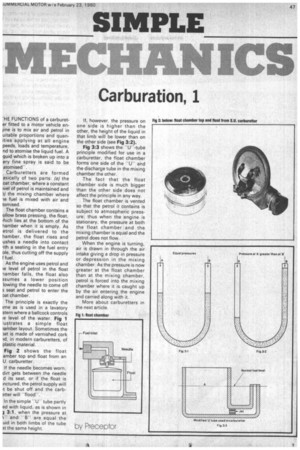Carburation, 1
Page 49

If you've noticed an error in this article please click here to report it so we can fix it.
HE FUNCTIONS of a carbureter fitted to a motor vehicle enline is to mix air and petrol in uitable proportions and quanities applying at all engine peeds, loads and temperature, nd to atomise the liquid fuel. A quid which is broken up into a ery fine spray is said to be atomised".
Carburetters are formed asically of two parts: (a) the oat chamber, where a constant wel of petrol is maintained and )) the mixing chamber where le fuel is mixed with air and tomised.
The float chamber contains a ollow brass pressing, the float, thich lies at the bottom of the lamber when it is empty. As etrol is delivered to the hamber, the float rises and ushes a needle into contact ,ith a seating in the fuel entry ole, thus cutting off the supply f fuel.
As the engine uses petrol and le level of petrol in the float iamber falls, the float also ssumes a lower position lowing the needle to come off 3 seat and petrol to enter the at chamber.
The principle is exactly the trne as is used in a lavatory stern where a ballcock controls le level of the water. Fig 1 ustrates a simple float taMber layout. Sometimes the )at is made of varnished cork Id, in modern carburetters, of plastic material.
Fig 2 shows the float amber top and float from an U. carburetter.
If the needle becomes worn, dirt gets between the needle d its seat, or if the float is inctu red, the petrol supply will t be shut off and the carbatter will "flood'', In the simple "U" tube partly ed with liquid, as is shown in 3 3:1, when the pressure at k" and "B" are equal the uid in both limbs of the tube at the same height. If, however, the pressure on one side is higher than the other, the height of the liquid in that limb will be lower than on the other side (see Fig 3:2).
Fig 3:3 shows the "U"-tube principle modified for use in a carburetter, the float chamber forms one side of the "U" and the discharge tube in the mixing chamber the other.
The fact that the float chamber side is much bigger than the other side does not affect the principle in any way.
The float chamber is vented so that the petrol it contains is subject to atmospheric pressure; thus when the engine is stationary, the pressure at both the float chamber and the mixing chamber is equal and the petrol does not flow.
When the engine is turning, air is drawn in through the air intake giving a drop in pressure or depression in the mixing chamber. As the pressure is now greater at the float chamber than at the mixing chamber, petrol is forced into the mixing chamber where it is caught up by the air entering the engine and carried along with it.
More about carburetters in the next article.




































































































































